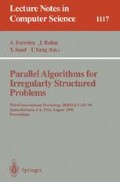Abstract
A set of tools is introduced which allow engineers and scientists to obtain solutions to large finite-element problems by utilizing multiple-instruction, multiple-data (MIMD) parallel computers. The finite-element mesh is decomposed so that each resulting sub-domain is connected to at most two other subdomains. The node-numbering of the decomposed mesh is such that the resulting set of finite element equations will have a border-block diagonal structure. A parallel algorithm is used to assemble, factor and solve the set of simultaneous algebraic equations that result from the finite-element method (FEM). In this paper, we demonstrate the method on a message passing parallel computer for two- and three-dimensional electrostatic problems, governed by Laplace's equation. Results and performance data for the algorithm as applied to electrostatics problems are given. The current work is an extension of the algorithm described and implemented in Reference [1].
Preview
Unable to display preview. Download preview PDF.
References
G. L. Hennigan, S. P. Castillo, and E. C. Hensel, Using domain decomposition to solve symmetric, positive-definite systems on the hypercube computer, Inter, j. numer. methods eng., 33, No. 9, 1940–1954 (1992).
K. Gallivan, R. Plemmons, and A. Sameh, Parallel algorithms for dense linear algebra computations, SIAM Rev., 32, 54–135 (1990).
B. A. Hendrickson and D. E. Womble, The torus-wrap mapping for dense matrix calculations on massively parallel computers, Tech. Rep. SAND92-0792, Sandia National Laboratories, 1992.
D. B. Davidson, Large parallel processing revisited: A second tutorial, IEEE Ant. & Prop. Mag., 34, 9–21 (1992).
M. T. Heath, E. Ng, and B. W. Peyton, Parallel algorithms for sparse linear systems, SIAM Rev., 33, 420–460 (1991).
M. L. Barton and J. R. Rattner, Parallel computing and its impact on computational electromagnetics, IEEE Trans. on Mag., 28, 1690–1695 (1992).
G. A. Lyzenga and A. Raefsky, Implementing finite element software on hypercube machines, Assoc. Comput. Mach., 1755–1761 (1988).
A. George and J. W. Liu, Computer Solution of Large Sparse Positive Definite Systems, Prentice-Hall, Englewood Cliffis, N.J., 1981.
Author information
Authors and Affiliations
Editor information
Rights and permissions
Copyright information
© 1996 Springer-Verlag Berlin Heidelberg
About this paper
Cite this paper
Dearholt, W., Castillo, S., Hennigan, G. (1996). Solution of large, sparse, irregular systems on a massively parallel computer. In: Ferreira, A., Rolim, J., Saad, Y., Yang, T. (eds) Parallel Algorithms for Irregularly Structured Problems. IRREGULAR 1996. Lecture Notes in Computer Science, vol 1117. Springer, Berlin, Heidelberg. https://doi.org/10.1007/BFb0030096
Download citation
DOI: https://doi.org/10.1007/BFb0030096
Published:
Publisher Name: Springer, Berlin, Heidelberg
Print ISBN: 978-3-540-61549-1
Online ISBN: 978-3-540-68808-2
eBook Packages: Springer Book Archive

